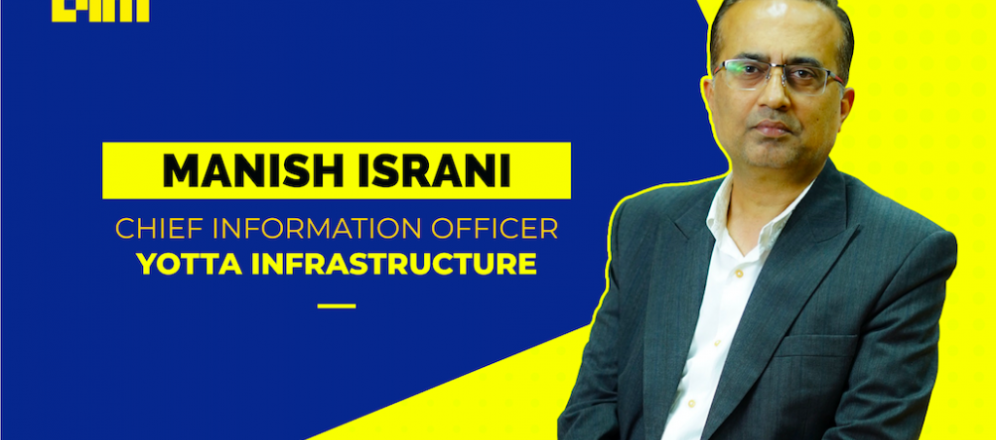Started in July 2019, Yotta Infrastructure is building hyper scalable, hyperdensity, multi-tenant data centre parks on fully managed services model to meet the ever-growing digital infrastructure needs of the country.
India’s data centre industry is booming, and that is reflected in our recent Union Budget where India’s finance minister proposed rolling out a policy to build data centre parks. Increase in data consumption and creation is inevitable, given the push for emerging technology adoption across industries, increasing number of interconnected devices, and increased usage of smartphones driven by low data tariffs. Even on the enterprise front, we are witnessing more and more businesses moving their workloads to the cloud, while getting benefitted from lower costs and efficient use of their IT infrastructure.
To understand more, Analytics India Magazine connected with Manish Israni, the executive VP and CIO at Yotta Infrastructure, to give us a detailed peek into the data centre space in India, and the ramifications of this critical market for cloud, data analytics and the future of computing. Started in July 2019, Yotta is building hyper scalable, hyperdensity, multi-tenant data centre parks on fully managed services model to meet the ever-growing digital infrastructure needs of the country.
Here are the edited excerpts from the interaction.
AIM: Yotta has announced the launch of India’s largest data centre. Can you describe what the objective is behind this move?
Manish Israni: In India, there are approximately 627 million active internet users, but the country has an abnormally low data centre capacity of less than 700 MW capacity. The Hiranandani group realised the rising potential of the business taking into consideration, the government’s digital initiatives like data localisation, technology up-gradation, and the increasing amount of data in the country. Cloud computing is helping enterprises scale-up very fast and as required. Our vision is to provide the highest quality data centre facilities at the most reasonable costs, which we have proved with our inaugural offer that has been designed to give unmatched pricing to enterprises looking to colocate.
AIM: Please elaborate on Yotta Infrastructure’s current tech stack. How are you using data and analytics for your solutions?
Manish Israni: Being a young company gives us the advantage to go in for the latest and emerging technologies. At Yotta, we use the latest technologies to ensure that we provide best-in-class products and services to our customers. Our Uptime Tier IV certification signifies our excellence in design, construction and operational sustainability. We use data and analytics to provide our customers with real-time updates through an easy-to-use dashboard. This dashboard is customisable depending on the requirements, and customers can use it to understand their usage of services. Also, all IT equipment arriving at our facilities are tagged, which allows us and our customers to get real-time location updates.
AIM: What are the challenges you faced while setting up a massive data centre?
Manish Israni: The challenges in setting up a hyperscale data centre commence only if there is an initial construction oversight or mismatch of planning and budgeting. These may occur due to poor management of processes, inexperienced teams, misaligned objectives and lack of third-party verification. While planning to set up a large data centre, the owner must ensure the availability of these resources — land, connectivity and power. They must identify a location which is close to fibre landing stations to attain a faster data transfer. The integration of complex systems, changes in design and infrastructure, and substitution of materials are some of the problems that need to be tackled in real-time while constructing a data centre to achieve high-quality data centre performance. While conceptualising Yotta’s data centres, we had the support of Hiranandani Group’s resources and our experienced team of experts to ensure that we are short of nothing to build top tier hyper-scale data centres.
AIM: What are the issues faced by enterprises while deploying various MSPs, and how does Yotta bridge that gap?
Manish Israni: Enterprises work with multiple cloud service providers for their day to day course of business. Cloud providers use data centres to host themselves. Using a colocation data centre provider would help them save cost, give scalability and also centrally manage their cloud services. Enterprises prefer to start small and expand as required; approaching an MSP will allow them to scale up or down depending on the demand. End-users of MSPs can access their resources from their place of work while experts will manage the infrastructure. Organisations also must meet the security standards set by their respective regulatory bodies; we move this burden of compliance off the in-house staff and provide secure data storage. Besides, MSPs also offer better connectivity, 24/7 availability and uninterrupted power supply, ensuring business-critical applications are running smoothly.
AIM: Which are the verticals that Yotta Infrastructure is targeting?
Manish Israni: Companies across sectors are increasingly adopting new technologies to provide enhanced services to their customers. Increase in data consumption due to cloud computing, data localisation and emerging technologies like IoT, ML and blockchain are leading to a rise in demand for data centre services in India. This trend will continue to grow over the coming years. Sectors like BFSI, OTT and e-commerce are major data creators, and we are in talks with some big players to provide the data centre services. BFSI segment also requires reliable data protection, disaster recovery; and has a massive reservoir of data for analysis, manufacturing sector, which is inclining towards IoT and automation. Hence, they are our takers for hybrid cloud solutions as well as colocation services.
AIM: Did the data centre market meet your expectations in 2019?
Manish Israni: Indian data centre market has been attracting huge investments from both new and existing players. This can be attributed to favourable conditions such as high mobile data consumption, rise in cloud computing, Digital India initiatives, data localisation norms, adoption of IoT and others. 2019 also saw the arrival of IT giant, Microsoft, in the Indian market and diversification of real estate players like Adani and Hiranandani Group into the data centre market. According to a report, the Indian data centre market size is expected to reach USD 4 billion by 2024, growing at a CAGR of 9%. Despite this, the gap is huge and requires at least 15 times more data centre capacity to address the ever-increasing data storage requirement.
AIM: What do you think about the allocation of data centre parks as part of the budget announcement?
Manish Israni: We are glad that the government understands the current scenario and is working towards the growth of the Indian data centre market. The announcement to come up with a policy to enable the private sector to build more data centre parks also supports the data localisation plans. Yotta has been working very closely with the Indian government to appraise them of the challenges the sector has been facing and has also proposed various strategies to accelerate and boost data centre growth in India. We expect to see more data centre parks in satellite towns within 100 km from major metro cities. Mumbai and Chennai will be the major attractions because of the fibre landing stations connecting India to the rest of the world and helping in international data replication, faster international data transfer, and vice versa.
AIM: What is Yotta’s strategy and roadmap in India for 2020?
Manish Israni: We have just launched our first data centre building, Yotta NM1 at the Yotta Data Centre Park in Panvel. Spread over 8.2 lakh square feet with a capacity of 7,200 racks and 50MW power, it will be almost 45% bigger than the largest data centre in India. Alongside, we will also launch an extensive suite of IT services under the name, ‘Yotta Tech Services’ through which we will extend our managed IT services, cloud services, connectivity, security and data centre build services to our customers. To conserve our predominant source of energy, Solar power, our group company is building a 279-acre solar power plant near Goa which will supply 40 MW of power to our Panvel data centre. This green energy will contribute to nearly 30% of our power requirements and will also offer our customers cost efficiencies. Our overall plan for the next five years is to make hyperscale data centre parks across Navi Mumbai, Mumbai and Chennai, with 60,000 racks and 500 MW of power.

















 Back
Back



